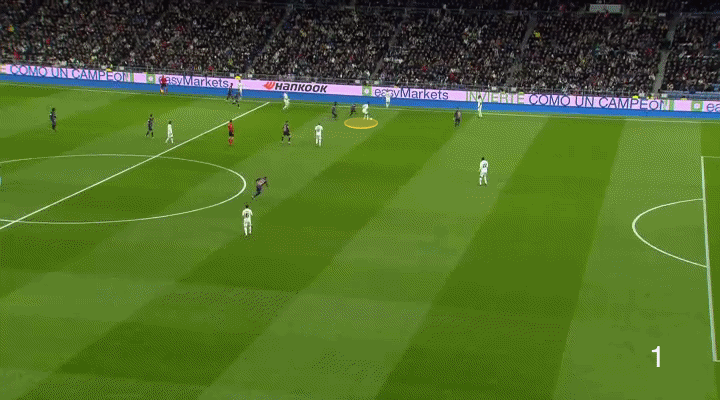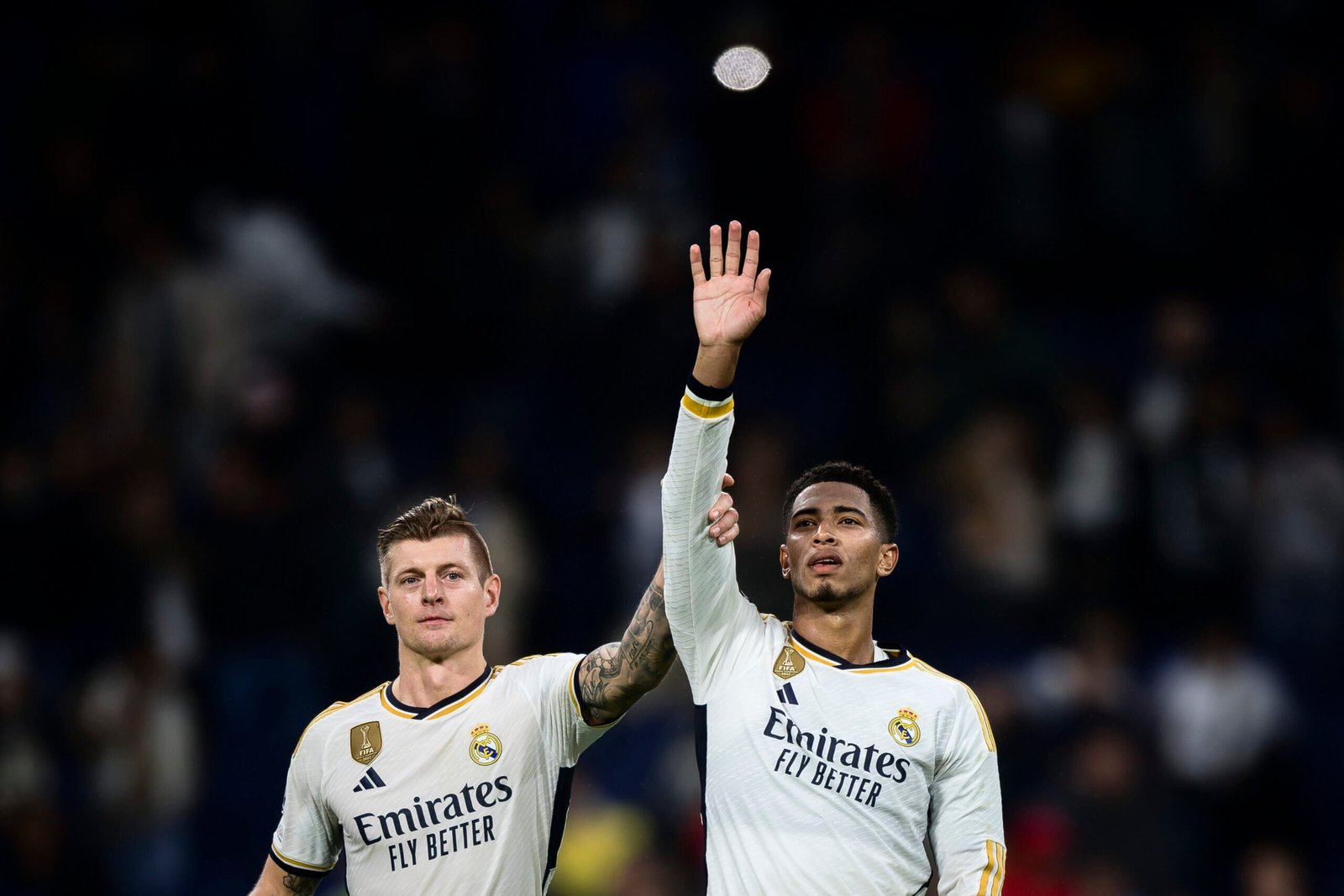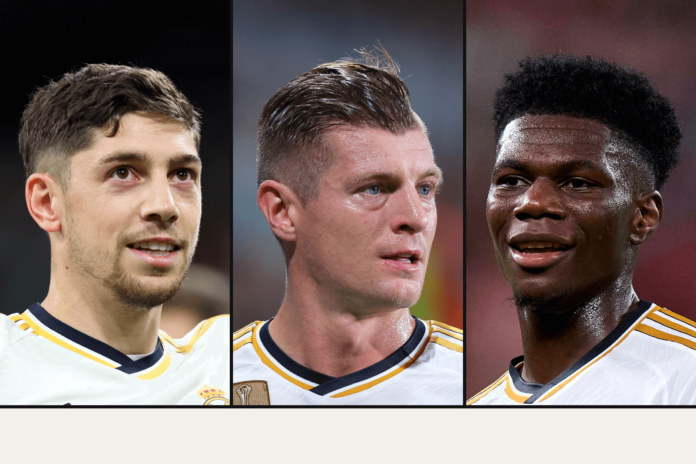After 10 years, 463 appearances, 21 trophies — with the potential for a 22nd in the Champions League final — and countless inch-perfect passes, Toni Kroos is retiring on a high at Real Madrid.
The announcement on Tuesday was a shock to his team-mates, many of whom posted tributes to the German on social media. The Spanish sports daily Marca led with a picture of his boots with the caption “They don’t make footballers like Kroos anymore”, while Madrid right-back Dani Carvajal echoed those sentiments as he arrived at an event in Madrid.
“You can’t replace him,” he told reporters with a smile. “There will be players who can get close to him, but Toni is unique.”
Carvajal is right: Kroos’ range of passing, reading of the game and NFL quarterback-esque performances will be impossible to find in one player. This season, he has the most touches (2,613), the most successful passes (2,134; compared to second-placed Federico Valverde’s 1,832) and the highest passing accuracy (95 per cent) of any Madrid player in La Liga.
But Madrid must get used to life after him. Who could step up in his absence?
This season, Kroos has played as a left-sided central midfielder in Carlo Ancelotti’s hybrid 4-4-2 formation and regularly drops deep, even positioning himself between Madrid’s centre-backs to launch attacks.
As the scatter graph below shows, no Madrid midfielder comes close when it comes to long-range passing.
But Tchouameni could make sense from that perspective. The 24-year-old Frenchman is the midfielder with the closest passing accuracy to Kroos (92 per cent), excels as a sole defensive pivot and has similar vision on the ball. Just consider his raking cross-field pass in the build-up to Arda Guler’s goal against Real Sociedad last month.
🇹🇷 Cómo celebrar tu primera titularidad con el @realmadrid.
🌟 @10ardaguler ⚽#LALIGAEASPORTS | #LALIGAHighlights pic.twitter.com/QBhU0oIB9B
— LALIGA (@LaLiga) April 30, 2024
Kroos is not known for his defensive prowess but rarely gives the ball away. His low possession-lost percentage of 8.6 in all competitions is similar to Tchouameni’s 9.4 and the former Monaco midfielder actually beats him in the percentage of his duels won, with 62.9 per cent compared to Kroos’ 62.5.
Tchouameni has filled in for Kroos when he has been unavailable this term and started alongside him in both legs of the Champions League semi-final against Bayern Munich. He has taken most of his touches on the right side of midfield but his influence mirrors Kroos’ on the left.
Eduardo Camavinga
Perhaps the most obvious fit for the Kroos role given he plays in the same spaces on the left for Madrid.
Kroos’ timeless form helps explain why Camavinga has not established himself in the starting XI since his arrival at the Santiago Bernabeu nearly three years ago. The 21-year-old has had to deputise at left-back or in defensive midfield instead, despite not being a natural in either position.
Camavinga is confident on the ball and more mobile than Kroos, often pushing forward to join the attack. But he is raw and has sometimes been caught out in possession. It’s hard to imagine Kroos ever losing control in as dangerous a position as this, from a Copa del Rey Clasico in March last year.
Carvajal throws to the Frenchman, who underhits a backpass — allowing Gavi and Franck Kessie to pounce in the build-up to a calamitous own-goal from Eder Militao.

Even so, Camavinga is tenacious. He has made 98 tackles this season (although he has played six times at left-back) — more than Kroos (76), Tchouameni (51) and Luka Modric (28).
Swapping Kroos for him could bring new energy to that side of midfield. Coaching staff sources — who asked to remain anonymous to protect relationships — told The Athletic they were not planning for any midfield signings this summer, meaning there would be more chances for Camavinga to start.
Bellingham has impressed everyone with his goalscoring feats in a more advanced role this term, but those coaching staff sources also say Ancelotti could move him back to midfield next season.
That would make sense given Kylian Mbappe is expected to arrive from Paris Saint-Germain this summer and the Brazilian striker Endrick will join up with his new team-mates when he turns 18. Ancelotti’s staff have not discounted the possibility of moving from the hybrid 4-4-2 formation they have used this season to one with three midfielders to solve that dilemma in attack.
Kroos may have been hinting at a new role for Bellingham when he replied to the Englishman’s tribute on social media. “You are more than ready to take over,” he wrote.

Could Bellingham be Kroos’ successor? (Nicolo Campo/LightRocket via Getty Images)
Bellingham commands similar respect to Kroos despite being 14 years his junior but has played as a No 10, a left-sided midfielder and even as a forward at times this season. He loses possession more often (16 per cent) than any of Kroos, Modric, Camavinga or Tchouameni and is the only one of those players whose passing accuracy has dipped below 90 per cent (89.5).
Even so, he has been an integral part of Ancelotti’s side and is the only one of those players other than Kroos to break the 3,000-touch mark in all competitions — albeit in more than 450 minutes of playing time compared to the German.
Federico Valverde
Kroos’ message to Valverde was even more cryptic after the Uruguayan said he had grown up idolising him. “I’ll always be by your side and tomorrow we’ll talk about another subject… #8,” the German wrote.
“The heir to the No 8,” Vinicius Junior responded.
It is hard to see Valverde inheriting Kroos’ role and number, but the 25-year-old has played in every position for Madrid down their right-hand side. This season, he has mainly featured as a right-sided midfielder, helping out full-back Carvajal in defence and springing forward in attack.
The Kroos role would likely take away Valverde’s best traits: his energy up and down the pitch and his ability to break up opposition attacks. His 157 recoveries are more than any of these midfielders in La Liga, but he lacks the German’s composure on the ball. Even so, the coaching staff see him as a crucial player in giving the side balance and they think he will be key in the post-Kroos era.
“Valverde is essential,” one source said. “It was the same two seasons ago (when Madrid won their 14th European Cup/Champions League and La Liga), and in this one again.”
Luka Modric
Modric and Kroos began the season playing reduced roles — but while the latter made himself indispensable once more, Modric has started just 23 of 51 possible games.
Modric’s future is uncertain — his contract is up in the summer — but Kroos’ retirement could open more opportunities. The 38-year-old has registered eight assists despite his limited playing time (Kroos has nine), created 76 chances to Kroos’ 85 and plays a similar number of passes into the box (196 to Kroos’ 214).

Modric and Kroos lift the La Liga trophy this month (Helios de la Rubia/Real Madrid via Getty Images)
A deeper role might suit the ageing Modric, even if Kroos sitting back usually allows him to roam forward.
But the pair were benched early in the season as the Madrid hierarchy wanted the team’s young midfielders to be given a chance. Replacing Kroos with his long-time midfield partner would not help that process of renewal.
Looking elsewhere?
There is no indication that Madrid are looking to the transfer market to replace Kroos, largely because of the young midfielders they have recruited in recent years.
Valverde signed from Penarol in 2017, Camavinga joined from Rennes in 2021 and Tchouameni arrived from Monaco a year later. The succession plan for the midfield trio of Casemiro, Modric and Kroos has been in place for a while (Modric would be the sole survivor if he extends his deal this summer, after Casemiro’s departure to Manchester United in 2022).
But none of them can fully replace Kroos. Madrid may have to look to multiple midfielders to do the job of one Kroos, or even change style entirely according to coaching staff sources. It’s the best illustration of the German’s influence in the Spanish capital.
Additional contributor: Thom Harris
(Top photo: Getty Images)
Read the full article here


